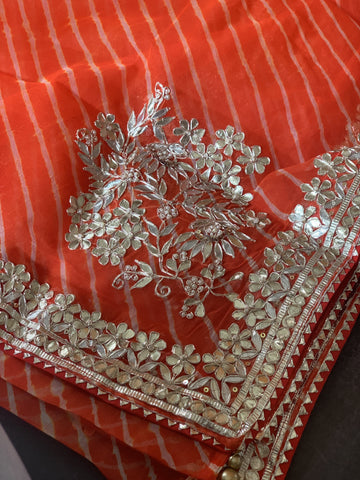Leheriya - a colourful traditional textile from the land of Deserts
Mita Kapur, The Hindu, "The famous Leheriya (zigzag pattern of irregular colour stripes) is a visual invocation of the flow of water at the same time painstakingly showing the depths of indigo after multiple mud-resistant and dyeing processes. No small wonder that the blues in Leheriya attract the eyes instinctively."
Evolving from the rural areas of Jodhpur, Jaipur, and Udaipur in Rajasthan, Chowdhrain is proud to introduce the exquisite patterns of Leheriya through our latest saree collection "Rangeelo."
The word ‘leheriya’ means ‘wave’, and is a well-known Indian textile craft. Handmade crafts are made with vividly coloured fabrics and unique patterns. A leheriya saree is distinguished from other sarees by the traditional way of tying and dyeing. The sarees from our Rangeelo collection have their signature diagonal stripe or by systematically dyeing knotted material leaving wavy designs in a wide range of variety colours for you to adorn and flaunt. Beautiful zigzag ripples carved on bright and light coloured fabrics are a signature of our leheriya inspired Rangeelo saree collection.
Initially, Leheriya was done specifically for men as a standard part of male business attire during the 19th and early 20th centuries in Rajasthan.
Fast forward to the 21st century, it is now one of the classics that every woman has in her wardrobe. Want to know how leheriya sarees are traditionally made? Read on!
Traditionally, women are the only ones who tie the fabric for the Leheriya resist. Before dyeing, the cloth is folded diagonally, rolled and then tied at intervals to create the distinctive strip or chevron pattern. Then, the fabric is rolled up and is ready to be tied according to the design which you will absolutely love. It is no surprise that a traditional method such as Leheriya grabs people’s attention everywhere.
-
These dune patterns are further embellished with hand embroidery that enveloped traditional crafts practices of Rajasthan, which is centuries old, locally called “gota patti”, which translates to gota embroidery.

Gota is basically gold and silver lace which is made up of metal-coated weft yarn, while the warp yarn includes ribbons of fibres like cotton and polyester. Earlier, pure gold and silver threads were used for this purpose and were popular among the elites. Now, they are eventually replaced by copper coated with silver. A gota embroidery saree has its distinguished look, one that is classic and never out of style. From heavily embellished Mango motifs to smaller floral petals, the way this embroidery is etched to the fabric is fascinating. Traditional technique involved the ‘patti’ to be stitched onto the fabric by hand and not sticking it fabric glue that is currently practiced. We are glad to have followed this authentic practice which translates into better quality embroidery and safety.
Chowdhrain, works with handwoven textiles and traditional artisans to make a powerful statement for any wearer. Chowdhrain makes sure the roots of the dying process is still authentic, unaltered, and reaches our customer, raw and perfect.
We are pretty sure you are waiting to grab the perfect saree for you! Why wait?
Visit https://chowdhrain.com/collections/leheriya and grab yours now!